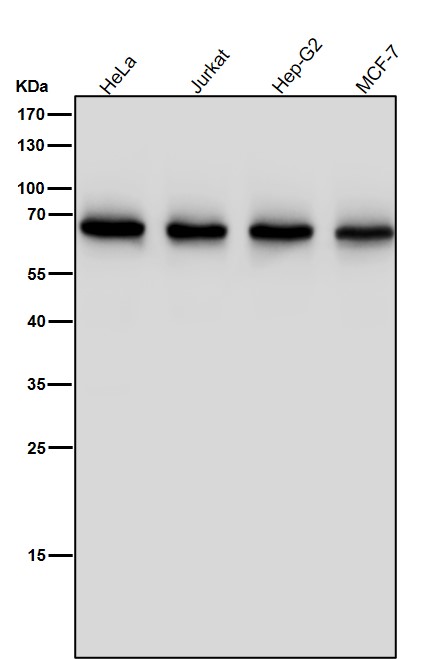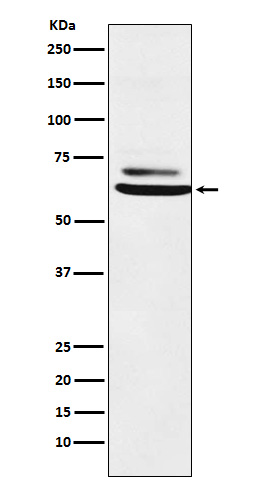Anti-ENT2 Rabbit Monoclonal Antibody
- SPECIFICATION
- CITATIONS
- PROTOCOLS
- BACKGROUND

Application
| WB, IHC, IF, ICC, FC |
|---|---|
| Primary Accession | Q14542 |
| Host | Rabbit |
| Isotype | IgG |
| Reactivity | Rat, Human, Mouse |
| Clonality | Monoclonal |
| Format | Liquid |
| Description | Anti-ENT2 Rabbit Monoclonal Antibody . Tested in WB, IHC, ICC/IF, Flow Cytometry applications. This antibody reacts with Human, Mouse, Rat. |
| Gene ID | 3177 |
|---|---|
| Other Names | Equilibrative nucleoside transporter 2, hENT2, 36 kDa nucleolar protein HNP36, Delayed-early response protein 12, Equilibrative nitrobenzylmercaptopurine riboside-insensitive nucleoside transporter, Equilibrative NBMPR-insensitive nucleoside transporter, Hydrophobic nucleolar protein, 36 kDa, Nucleoside transporter, ei-type, Solute carrier family 29 member 2, SLC29A2 (HGNC:11004), DER12, ENT2, HNP36 |
| Calculated MW | 55-65 kDa |
| Application Details | WB 1:500-1:2000 IHC 1:50-1:200 ICC/IF 1:50-1:200 FC 1:20 |
| Contents | Rabbit IgG in phosphate buffered saline, pH 7.4, 150mM NaCl, 0.02% sodium azide and 50% glycerol, 0.4-0.5mg/ml BSA. |
| Clone Names | Clone: 22S87 |
| Immunogen | A synthesized peptide derived from human ENT2 |
| Purification | Affinity-chromatography |
| Storage | Store at -20°C for one year. For short term storage and frequent use, store at 4°C for up to one month. Avoid repeated freeze-thaw cycles. |
| Name | SLC29A2 (HGNC:11004) |
|---|---|
| Synonyms | DER12, ENT2, HNP36 |
| Function | Bidirectional uniporter involved in the facilitative transport of nucleosides and nucleobases, and contributes to maintaining their cellular homeostasis (PubMed:10722669, PubMed:12527552, PubMed:12590919, PubMed:16214850, PubMed:21795683, PubMed:9396714, PubMed:9478986). Functions as a Na(+)-independent, passive transporter (PubMed:9478986). Involved in the transport of nucleosides such as inosine, adenosine, uridine, thymidine, cytidine and guanosine (PubMed:10722669, PubMed:12527552, PubMed:12590919, PubMed:16214850, PubMed:21795683, PubMed:9396714, PubMed:9478986). Also able to transport purine nucleobases (hypoxanthine, adenine, guanine) and pyrimidine nucleobases (thymine, uracil) (PubMed:16214850, PubMed:21795683). Involved in nucleoside transport at basolateral membrane of kidney cells, allowing liver absorption of nucleoside metabolites (PubMed:12527552). Mediates apical nucleoside uptake into Sertoli cells, thereby regulating the transport of nucleosides in testis across the blood-testis-barrier (PubMed:23639800). Mediates both the influx and efflux of hypoxanthine in skeletal muscle microvascular endothelial cells to control the amount of intracellular hypoxanthine available for xanthine oxidase-mediated ROS production (By similarity). |
| Cellular Location | Apical cell membrane; Multi-pass membrane protein. Basolateral cell membrane; Multi-pass membrane protein. Note=Localized to the apical membrane of Sertoli cells. |
| Tissue Location | Highly expressed in skeletal muscle (PubMed:9478986). Expressed in liver, lung, placenta, brain, heart, kidney and ovarian tissues (PubMed:9478986). Expressed in testis at the blood-brain-barrier (PubMed:23639800). |

Thousands of laboratories across the world have published research that depended on the performance of antibodies from Abcepta to advance their research. Check out links to articles that cite our products in major peer-reviewed journals, organized by research category.
info@abcepta.com, and receive a free "I Love Antibodies" mug.
Provided below are standard protocols that you may find useful for product applications.
If you have used an Abcepta product and would like to share how it has performed, please click on the "Submit Review" button and provide the requested information. Our staff will examine and post your review and contact you if needed.
If you have any additional inquiries please email technical services at tech@abcepta.com.













 Foundational characteristics of cancer include proliferation, angiogenesis, migration, evasion of apoptosis, and cellular immortality. Find key markers for these cellular processes and antibodies to detect them.
Foundational characteristics of cancer include proliferation, angiogenesis, migration, evasion of apoptosis, and cellular immortality. Find key markers for these cellular processes and antibodies to detect them. The SUMOplot™ Analysis Program predicts and scores sumoylation sites in your protein. SUMOylation is a post-translational modification involved in various cellular processes, such as nuclear-cytosolic transport, transcriptional regulation, apoptosis, protein stability, response to stress, and progression through the cell cycle.
The SUMOplot™ Analysis Program predicts and scores sumoylation sites in your protein. SUMOylation is a post-translational modification involved in various cellular processes, such as nuclear-cytosolic transport, transcriptional regulation, apoptosis, protein stability, response to stress, and progression through the cell cycle. The Autophagy Receptor Motif Plotter predicts and scores autophagy receptor binding sites in your protein. Identifying proteins connected to this pathway is critical to understanding the role of autophagy in physiological as well as pathological processes such as development, differentiation, neurodegenerative diseases, stress, infection, and cancer.
The Autophagy Receptor Motif Plotter predicts and scores autophagy receptor binding sites in your protein. Identifying proteins connected to this pathway is critical to understanding the role of autophagy in physiological as well as pathological processes such as development, differentiation, neurodegenerative diseases, stress, infection, and cancer.



